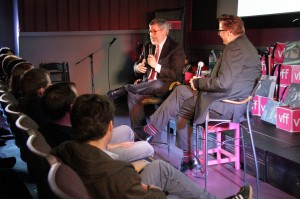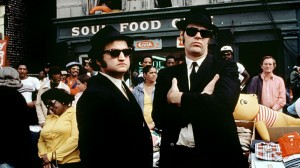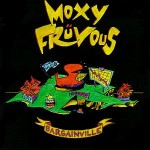Back in 1980, one movie challenged Hollywood’s colourblindness by showcasing some of America’s top rhythm and blues talent in the guise of a mainstream comedy. Not only did it revive the fading careers of the likes of Aretha Franklin, James Brown, John Lee Hooker and Ray Charles, but it also introduced a whole new generation to the timeless soul and funk of America’s R&B all-stars. Surprisingly, that movie was The Blues Brothers.
It’s surprising because few would ever describe that Dan Aykroyd/John Belushi vehicle as a powerful piece of black filmmaking—not even director John Landis. Hot off 1978’s unexpected hit frat-house comedy Animal House, which came in at #4 for box office moneymakers that year (just behind Grease and Superman), Landis was suddenly a director in demand . . . moreso than his previous two releases (1978’s Kentucky Fried Movie and 1973’s Schlock) would have ever predicted.
But, as the affable Landis told his audience at the Victoria Film Festival back in February, where he was doing a live Q&A with noted Canadian film journalist Richard Crouse, his heyday in the Hollywood spotlight was still a few years off—but he would never have been offered the likes of An American Werewolf in London, Trading Places or Michael Jackson’s Thriller had The Blues Brothers not hit all the right notes at just the right time.

Live from Los Angeles, it’s the Blues Brothers
No real surprise the director would choose to work with John Belushi immediately after Animal House—despite the comedian’s escalating drug habit, and then subsequent enrollment in rehabs for the treatment for addiction—especially since the original casting for Animal House was supposed to feature Aykroyd as well. And the popularity of the Blues Brothers as a legitimate band had mirrored Belushi’s own rise to Hollywood stardom since their debut performance opening for Steve Martin at the Los Angeles Amphitheater in 1978—an appearance which spawned their first album, Briefcase Full of Blues, which subsequently hit #1 on the Billboard 200 charts before going double-platinum and spinning off a pair of top-40 hits (their covers of “Soul Man” and “Rubber Biscuit”).
With Belushi and Aykroyd’s Jake and Elwood Blues personas now firmly fixed on the music charts, and their 1979 departure from Saturday Night Live, in retrospect it seems almost inevitable that they’d start looking for an onscreen outing for the Blues Brothers. But, as Landis told the VFF audience, the idea of showcasing black R&B stars didn’t exactly find a ready audience in American film distributors.
“‘This is a black movie,'” Landis recalled industry reps telling him after one preview screening. “‘White people won’t go see this.'” (They were wrong, of course: The Blues Brothers topped out at a respectable #10 for domestic box office in 1980, pulling in some $57 million that year alone.) He also recalled how the owner of the second largest theatre chain in the United States told him point-blank, “‘I won’t book this movie—I don’t want black people in my neighbourhoods.'”

No colour please, we’re mainstream America
Keep in mind Barack Obama was only 19 in 1980 and, as the future president was entering his 20s, America was about to embark upon the Reagan era. (To put that in context, Margaret Thatcher’s Conservative Party had already taken power in England and, here in Canada, Joe Clark’s Conservatives were about to unseat Trudeau’s Liberals.) And Martin Luther King Jr. Day, while first proposed in 1979, wouldn’t be officially observed until 1986. “MTV wouldn’t even play black acts until Michael Jackson’s Thriller,” Landis noted (without, it should be said, taking any credit for directing that breakthrough music video.)
Up on the silver screen, the only other top-10 films with significant black roles that year were Stir Crazy (Richard Prior) and The Empire Strikes Back (Billy Dee Williams’ turn as Lando Calrissian). Check the AM dial and the only notable black acts were “safe” disco hits like Gloria Gaynor’s “I Will Survive,” Donna Summer’s “Bad Girls” and Diana Ross’ forgettable “Upside Down,” as well as the radio-friendly likes of Michael Jackson’s “Don’t Stop Till You Get Enough.” TV wasn’t much better, with only The Jeffersons widely challenging the colour bar. And while the fading disco era was just evolving into what would become electronica’s Chicago and Detroit house movements, it was still early days for black America’s hip hop scene, leaving R&B as the main game on the wrong side of town.
Enter Aykroyd and Belushi who, as Landis told us, “exploited their celebrity to promote this kind of music. The whole ‘mission for God’ line in the movie was me making fun of Danny Aykroyd because he was such an evangelist for rhythm & blues.” And while it’s easy now to look back in awe at the lineup of R&B royalty he was able to feature in the film—Aretha Franklin, James Brown, John Lee Hooker, Ray Charles, Cab Calloway—Landis admitted it wasn’t hard to interest them, since all had been in career slumps since the mid-’70s.
“When we started in 1979, R&B was considered over,” he told the Victoria Film Festival’s mostly white audience. “None of the ‘name’ acts in the film were big at the time—the only one who had any sort of career was Ray Charles, who was doing country & western. It wasn’t so much, ‘How can we get them on board?’ . . . we’d just pick up the telephone and they were, like, ‘Okay, I’m, in.'”
Note should also be made of the outstanding support band behind Jake and Elwood, which Saturday Night Live keyboardist and bandleader Paul Schaffer helped Belushi and Aykroyd form: blues guitar great Matt Murphy, Blood, Sweat & Tears trombonist Tom Malone, SNL sax player Lou Marini, plus the famed likes of Donald “Duck” Dunn and Steve Cropper—two of the three MGs behind Booker T & the MGs. (Cropper also co-wrote such iconic hits as “Sittin’ on the Dock of the Bay”, “In the Midnight Hour” and “Knock on Wood.”)
Can you dig it?
When asked what makes The Blues Brothers still so memorable, Landis didn’t even hesitate. “It’s really the music more than anything,” he readily admitted. “The musicians . . . it was amazing working with those guys. John Lee Hooker was live, James Brown was live . . . the others [Aretha Franklin and Ray Charles] were recorded, although they did have trouble with the lip-synching, because they never sing a song the same way twice. But the whole point of the movie was to introduce you to rhythm & blues.”
And it seemed to work: following the box-office success of The Blues Brothers, interest in all of the major R&B acts in the film surged again, with their music careers getting a much-needed kickstart that has never really faded. The Blues Brothers themselves scored another top-40 hit with “Gimme Some Lovin'” once the film’s top-selling soundtrack hit the stores, which led to a national tour and their third album, Made in America . . . the last album cut before Belushi’s death in 1982.
The film’s other contribution to popular culture? Reviving the popularity of Ray-Ban Wayfarer sunglasses (a look Belushi copied from John Lee Hooker himself). As Landis explained, they needed about 250 pairs of Wayfarers to film The Blues Brothers, but since they were considered “black” sunglasses, Ray-Ban had cut production by then and he had to send people out to scour black neighbourhoods across America just to find enough pairs for the shoot. (Of course, following the success of the film, Ray-Ban quickly struck a juicy $50,000 Hollywood product-placement deal and soon found themselves forever linked with Tom Cruise’s face as a result of 1983’s Risky Business.)
A mission from god, indeed
Looking back , it’s easy to write The Blues Brothers off as yet another lame-ass, overblown Saturday Night Live sketch writ large (or indeed, the film that made all those other lame-ass, overblown SNL sketches-turned-movies possible), but Landis is clearly pleased with its legacy—despite the film’s inherent problems: the cuts the studio insisted upon to make the film more palatable to mainstream white audiences, the ridiculousness of all those automotive pile-ups (which, contrary to popular myth, did not set a record for the most number of car crashes onscreen to date—as Landis explained, “We had a 24-hour bondo shop working in Chicago . . . one car would have 50 to 60 collisions, then get repaired overnight and be ready to shoot again”), and Belushi’s escalating drug abuse. “By midway through the movie, it was getting really bad,” Landis said. “We were all surprised he lived as long as he did . . . I’m still angry with him [for dying].”
Yet it’s the surprising cultural impact and bending of the colour bar that obviously keeps The Blues Brothers close to John Landis’ heart. Who knew that two fictional white-trash brothers from Chicago would lead to an unexpected merging of mainstream popular culture and black R&B?
—————-
A specialist in popular culture, John Threlfall has been a freelance writer for over 20 years, including a five-year stint as the “walking encyclopedia of popular culture” for CBC Radio One’s Definitely Not The Opera and 12 years on staff at the Victoria-based alternative weekly Monday Magazine. He was also one of six Canadian Gen-Xers featured in the NFB documentary Le Temps X and co-authored the quirky guidebook Victoria: Secrets of the City for Arsenal Pulp Press. By day, you can find him working in the University of Victoria’s Faculty of Fine Arts; by night, he’s usually in a darkened theatre keeping busy as one of Victoria’s theatre critics.



